Evidence Based Practice and Patient Outcomes: Position Statement
VerifiedAdded on 2020/03/16
|12
|2587
|323
Report
AI Summary
This report is an individual position statement on evidence-based practice (EBP) in nursing. It begins with an executive summary highlighting the importance of EBP in integrating research with nursing practices to improve patient care. The report then delves into the advantages of EBP, both theoretically and clinically, contrasting it with traditional practices. It explores the PICO model (Patient, Intervention, Comparison, Outcome) for clinical application and discusses the limitations of EBP, such as uncertainties in randomized control trials and the exclusion of experience-based decision-making. The report also covers the context and assumptions behind EBP, including gaps between research and practice, poor research quality, information overload, and the prevalence of non-evidence-based practices. The conclusion emphasizes that EBP is the future of nursing, paving the way for effective developments in the field while acknowledging the need for skilled practitioners and addressing the financial expenses involved. The report references key literature to support its arguments.
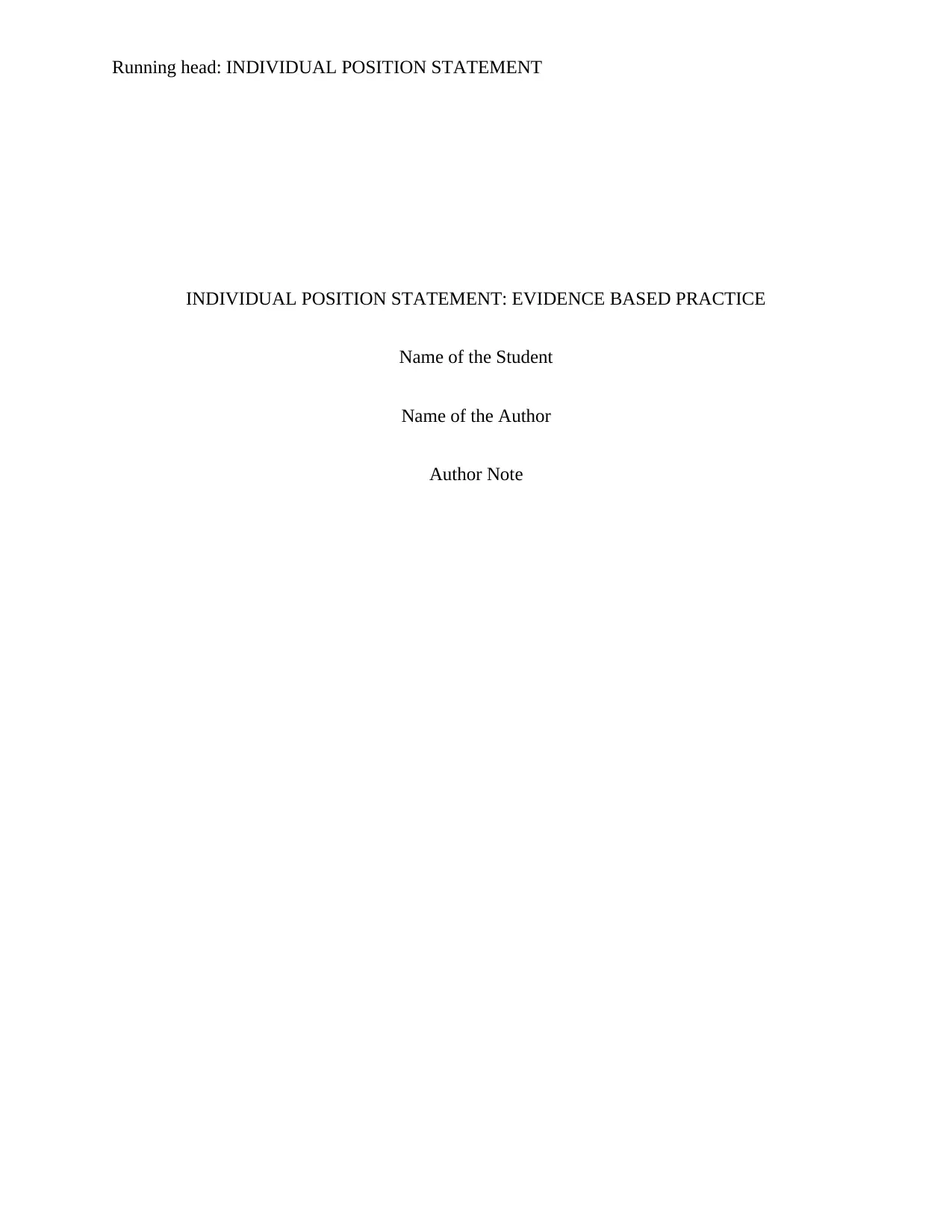
Running head: INDIVIDUAL POSITION STATEMENT
INDIVIDUAL POSITION STATEMENT: EVIDENCE BASED PRACTICE
Name of the Student
Name of the Author
Author Note
INDIVIDUAL POSITION STATEMENT: EVIDENCE BASED PRACTICE
Name of the Student
Name of the Author
Author Note
Paraphrase This Document
Need a fresh take? Get an instant paraphrase of this document with our AI Paraphraser
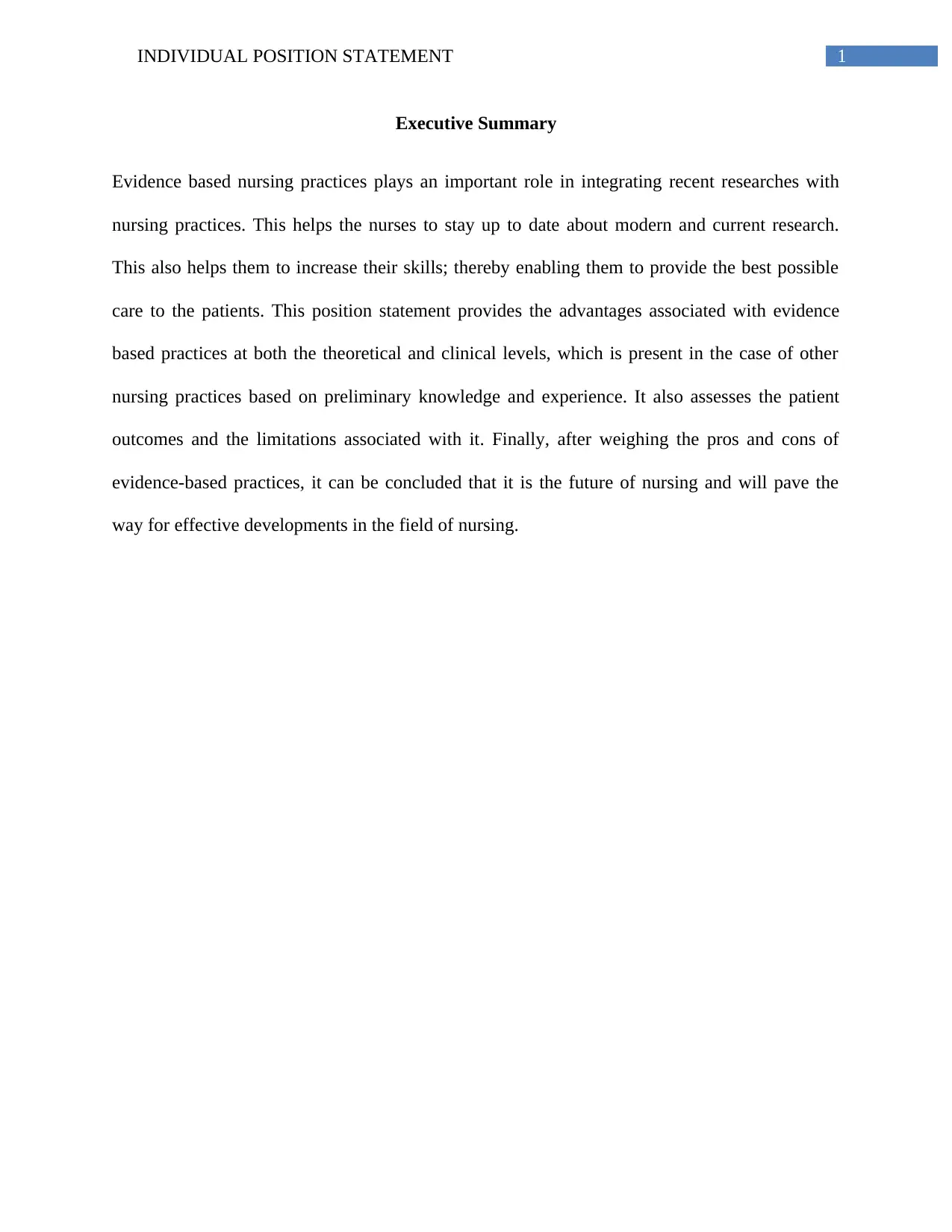
1INDIVIDUAL POSITION STATEMENT
Executive Summary
Evidence based nursing practices plays an important role in integrating recent researches with
nursing practices. This helps the nurses to stay up to date about modern and current research.
This also helps them to increase their skills; thereby enabling them to provide the best possible
care to the patients. This position statement provides the advantages associated with evidence
based practices at both the theoretical and clinical levels, which is present in the case of other
nursing practices based on preliminary knowledge and experience. It also assesses the patient
outcomes and the limitations associated with it. Finally, after weighing the pros and cons of
evidence-based practices, it can be concluded that it is the future of nursing and will pave the
way for effective developments in the field of nursing.
Executive Summary
Evidence based nursing practices plays an important role in integrating recent researches with
nursing practices. This helps the nurses to stay up to date about modern and current research.
This also helps them to increase their skills; thereby enabling them to provide the best possible
care to the patients. This position statement provides the advantages associated with evidence
based practices at both the theoretical and clinical levels, which is present in the case of other
nursing practices based on preliminary knowledge and experience. It also assesses the patient
outcomes and the limitations associated with it. Finally, after weighing the pros and cons of
evidence-based practices, it can be concluded that it is the future of nursing and will pave the
way for effective developments in the field of nursing.
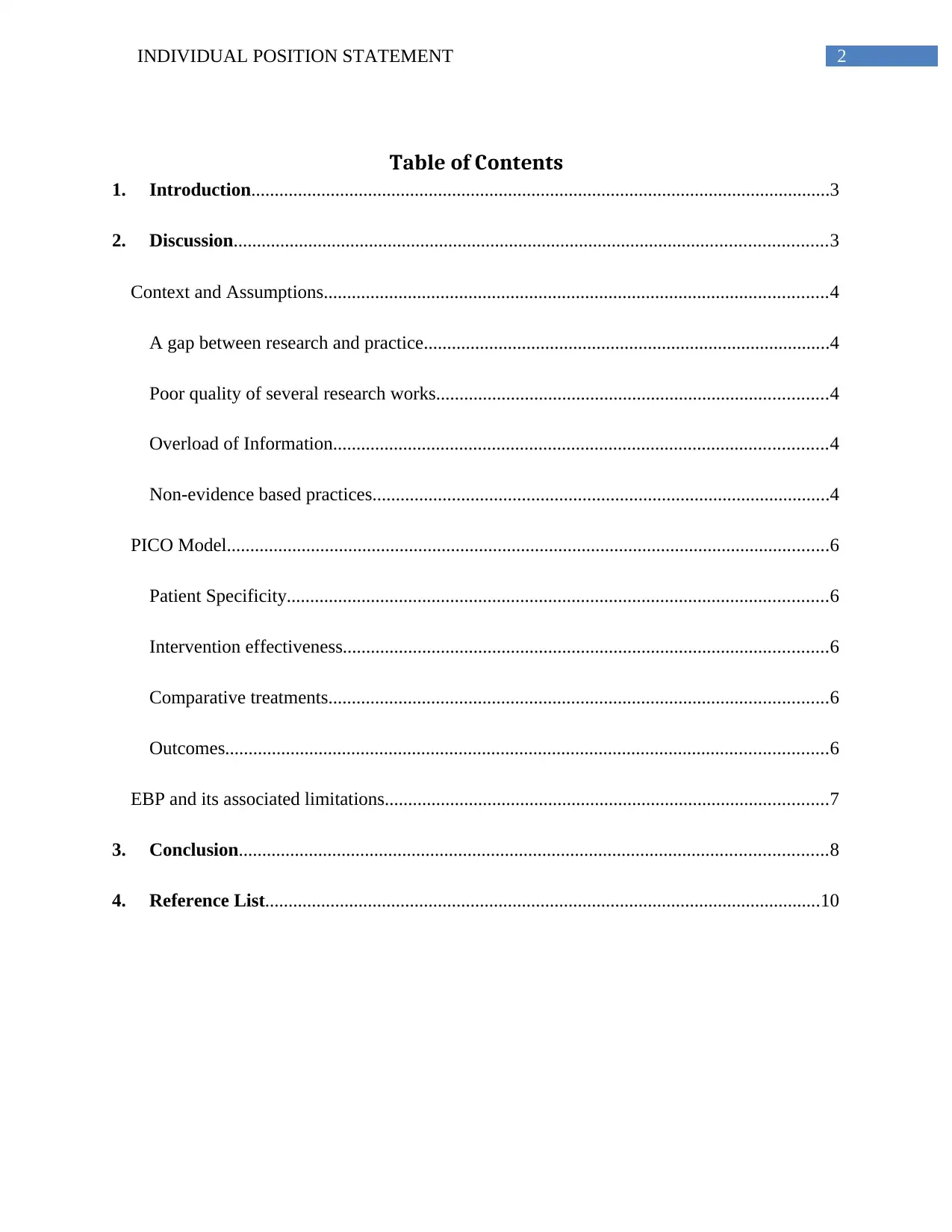
2INDIVIDUAL POSITION STATEMENT
Table of Contents
1. Introduction............................................................................................................................3
2. Discussion...............................................................................................................................3
Context and Assumptions............................................................................................................4
A gap between research and practice.......................................................................................4
Poor quality of several research works....................................................................................4
Overload of Information..........................................................................................................4
Non-evidence based practices..................................................................................................4
PICO Model.................................................................................................................................6
Patient Specificity....................................................................................................................6
Intervention effectiveness........................................................................................................6
Comparative treatments...........................................................................................................6
Outcomes.................................................................................................................................6
EBP and its associated limitations...............................................................................................7
3. Conclusion..............................................................................................................................8
4. Reference List.......................................................................................................................10
Table of Contents
1. Introduction............................................................................................................................3
2. Discussion...............................................................................................................................3
Context and Assumptions............................................................................................................4
A gap between research and practice.......................................................................................4
Poor quality of several research works....................................................................................4
Overload of Information..........................................................................................................4
Non-evidence based practices..................................................................................................4
PICO Model.................................................................................................................................6
Patient Specificity....................................................................................................................6
Intervention effectiveness........................................................................................................6
Comparative treatments...........................................................................................................6
Outcomes.................................................................................................................................6
EBP and its associated limitations...............................................................................................7
3. Conclusion..............................................................................................................................8
4. Reference List.......................................................................................................................10
⊘ This is a preview!⊘
Do you want full access?
Subscribe today to unlock all pages.

Trusted by 1+ million students worldwide
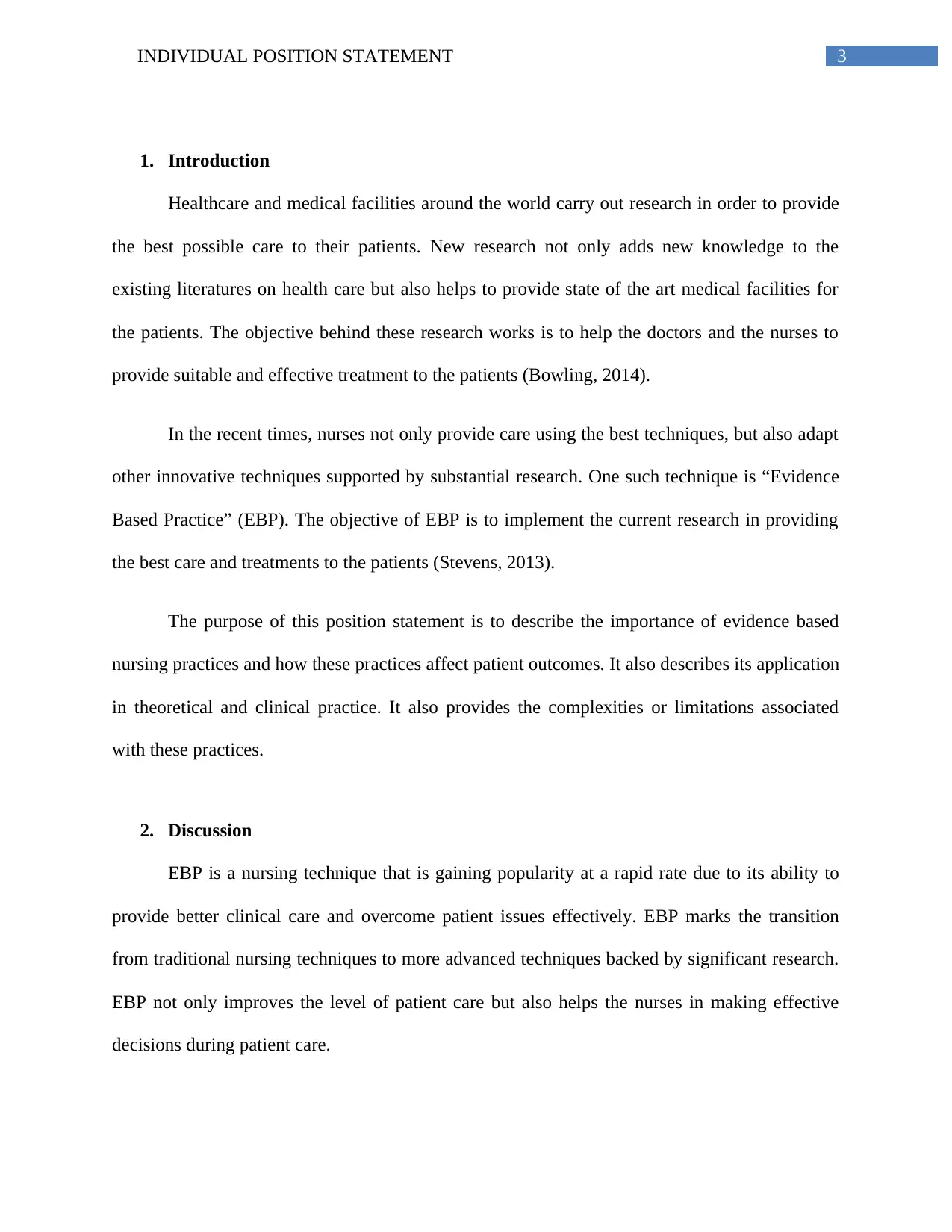
3INDIVIDUAL POSITION STATEMENT
1. Introduction
Healthcare and medical facilities around the world carry out research in order to provide
the best possible care to their patients. New research not only adds new knowledge to the
existing literatures on health care but also helps to provide state of the art medical facilities for
the patients. The objective behind these research works is to help the doctors and the nurses to
provide suitable and effective treatment to the patients (Bowling, 2014).
In the recent times, nurses not only provide care using the best techniques, but also adapt
other innovative techniques supported by substantial research. One such technique is “Evidence
Based Practice” (EBP). The objective of EBP is to implement the current research in providing
the best care and treatments to the patients (Stevens, 2013).
The purpose of this position statement is to describe the importance of evidence based
nursing practices and how these practices affect patient outcomes. It also describes its application
in theoretical and clinical practice. It also provides the complexities or limitations associated
with these practices.
2. Discussion
EBP is a nursing technique that is gaining popularity at a rapid rate due to its ability to
provide better clinical care and overcome patient issues effectively. EBP marks the transition
from traditional nursing techniques to more advanced techniques backed by significant research.
EBP not only improves the level of patient care but also helps the nurses in making effective
decisions during patient care.
1. Introduction
Healthcare and medical facilities around the world carry out research in order to provide
the best possible care to their patients. New research not only adds new knowledge to the
existing literatures on health care but also helps to provide state of the art medical facilities for
the patients. The objective behind these research works is to help the doctors and the nurses to
provide suitable and effective treatment to the patients (Bowling, 2014).
In the recent times, nurses not only provide care using the best techniques, but also adapt
other innovative techniques supported by substantial research. One such technique is “Evidence
Based Practice” (EBP). The objective of EBP is to implement the current research in providing
the best care and treatments to the patients (Stevens, 2013).
The purpose of this position statement is to describe the importance of evidence based
nursing practices and how these practices affect patient outcomes. It also describes its application
in theoretical and clinical practice. It also provides the complexities or limitations associated
with these practices.
2. Discussion
EBP is a nursing technique that is gaining popularity at a rapid rate due to its ability to
provide better clinical care and overcome patient issues effectively. EBP marks the transition
from traditional nursing techniques to more advanced techniques backed by significant research.
EBP not only improves the level of patient care but also helps the nurses in making effective
decisions during patient care.
Paraphrase This Document
Need a fresh take? Get an instant paraphrase of this document with our AI Paraphraser
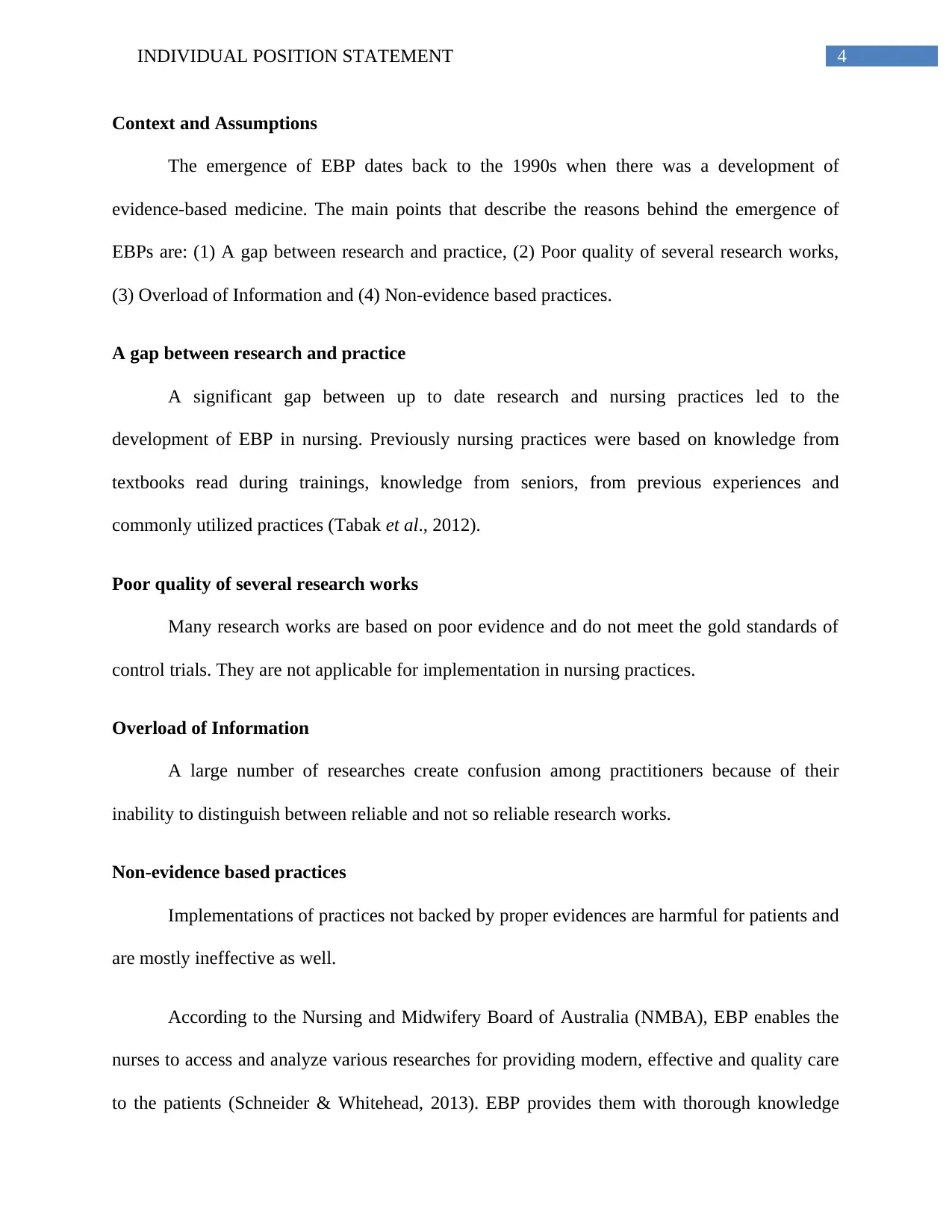
4INDIVIDUAL POSITION STATEMENT
Context and Assumptions
The emergence of EBP dates back to the 1990s when there was a development of
evidence-based medicine. The main points that describe the reasons behind the emergence of
EBPs are: (1) A gap between research and practice, (2) Poor quality of several research works,
(3) Overload of Information and (4) Non-evidence based practices.
A gap between research and practice
A significant gap between up to date research and nursing practices led to the
development of EBP in nursing. Previously nursing practices were based on knowledge from
textbooks read during trainings, knowledge from seniors, from previous experiences and
commonly utilized practices (Tabak et al., 2012).
Poor quality of several research works
Many research works are based on poor evidence and do not meet the gold standards of
control trials. They are not applicable for implementation in nursing practices.
Overload of Information
A large number of researches create confusion among practitioners because of their
inability to distinguish between reliable and not so reliable research works.
Non-evidence based practices
Implementations of practices not backed by proper evidences are harmful for patients and
are mostly ineffective as well.
According to the Nursing and Midwifery Board of Australia (NMBA), EBP enables the
nurses to access and analyze various researches for providing modern, effective and quality care
to the patients (Schneider & Whitehead, 2013). EBP provides them with thorough knowledge
Context and Assumptions
The emergence of EBP dates back to the 1990s when there was a development of
evidence-based medicine. The main points that describe the reasons behind the emergence of
EBPs are: (1) A gap between research and practice, (2) Poor quality of several research works,
(3) Overload of Information and (4) Non-evidence based practices.
A gap between research and practice
A significant gap between up to date research and nursing practices led to the
development of EBP in nursing. Previously nursing practices were based on knowledge from
textbooks read during trainings, knowledge from seniors, from previous experiences and
commonly utilized practices (Tabak et al., 2012).
Poor quality of several research works
Many research works are based on poor evidence and do not meet the gold standards of
control trials. They are not applicable for implementation in nursing practices.
Overload of Information
A large number of researches create confusion among practitioners because of their
inability to distinguish between reliable and not so reliable research works.
Non-evidence based practices
Implementations of practices not backed by proper evidences are harmful for patients and
are mostly ineffective as well.
According to the Nursing and Midwifery Board of Australia (NMBA), EBP enables the
nurses to access and analyze various researches for providing modern, effective and quality care
to the patients (Schneider & Whitehead, 2013). EBP provides them with thorough knowledge
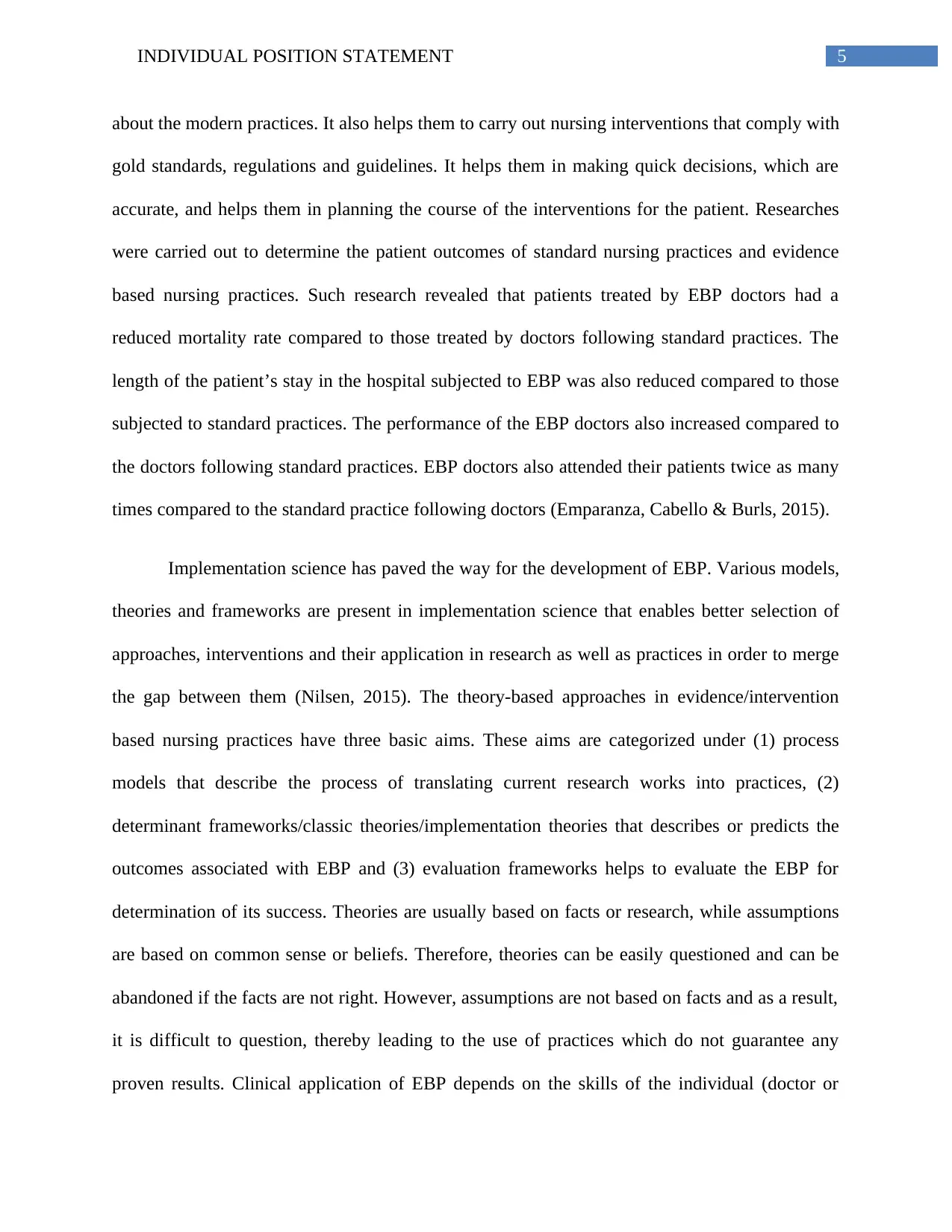
5INDIVIDUAL POSITION STATEMENT
about the modern practices. It also helps them to carry out nursing interventions that comply with
gold standards, regulations and guidelines. It helps them in making quick decisions, which are
accurate, and helps them in planning the course of the interventions for the patient. Researches
were carried out to determine the patient outcomes of standard nursing practices and evidence
based nursing practices. Such research revealed that patients treated by EBP doctors had a
reduced mortality rate compared to those treated by doctors following standard practices. The
length of the patient’s stay in the hospital subjected to EBP was also reduced compared to those
subjected to standard practices. The performance of the EBP doctors also increased compared to
the doctors following standard practices. EBP doctors also attended their patients twice as many
times compared to the standard practice following doctors (Emparanza, Cabello & Burls, 2015).
Implementation science has paved the way for the development of EBP. Various models,
theories and frameworks are present in implementation science that enables better selection of
approaches, interventions and their application in research as well as practices in order to merge
the gap between them (Nilsen, 2015). The theory-based approaches in evidence/intervention
based nursing practices have three basic aims. These aims are categorized under (1) process
models that describe the process of translating current research works into practices, (2)
determinant frameworks/classic theories/implementation theories that describes or predicts the
outcomes associated with EBP and (3) evaluation frameworks helps to evaluate the EBP for
determination of its success. Theories are usually based on facts or research, while assumptions
are based on common sense or beliefs. Therefore, theories can be easily questioned and can be
abandoned if the facts are not right. However, assumptions are not based on facts and as a result,
it is difficult to question, thereby leading to the use of practices which do not guarantee any
proven results. Clinical application of EBP depends on the skills of the individual (doctor or
about the modern practices. It also helps them to carry out nursing interventions that comply with
gold standards, regulations and guidelines. It helps them in making quick decisions, which are
accurate, and helps them in planning the course of the interventions for the patient. Researches
were carried out to determine the patient outcomes of standard nursing practices and evidence
based nursing practices. Such research revealed that patients treated by EBP doctors had a
reduced mortality rate compared to those treated by doctors following standard practices. The
length of the patient’s stay in the hospital subjected to EBP was also reduced compared to those
subjected to standard practices. The performance of the EBP doctors also increased compared to
the doctors following standard practices. EBP doctors also attended their patients twice as many
times compared to the standard practice following doctors (Emparanza, Cabello & Burls, 2015).
Implementation science has paved the way for the development of EBP. Various models,
theories and frameworks are present in implementation science that enables better selection of
approaches, interventions and their application in research as well as practices in order to merge
the gap between them (Nilsen, 2015). The theory-based approaches in evidence/intervention
based nursing practices have three basic aims. These aims are categorized under (1) process
models that describe the process of translating current research works into practices, (2)
determinant frameworks/classic theories/implementation theories that describes or predicts the
outcomes associated with EBP and (3) evaluation frameworks helps to evaluate the EBP for
determination of its success. Theories are usually based on facts or research, while assumptions
are based on common sense or beliefs. Therefore, theories can be easily questioned and can be
abandoned if the facts are not right. However, assumptions are not based on facts and as a result,
it is difficult to question, thereby leading to the use of practices which do not guarantee any
proven results. Clinical application of EBP depends on the skills of the individual (doctor or
⊘ This is a preview!⊘
Do you want full access?
Subscribe today to unlock all pages.

Trusted by 1+ million students worldwide
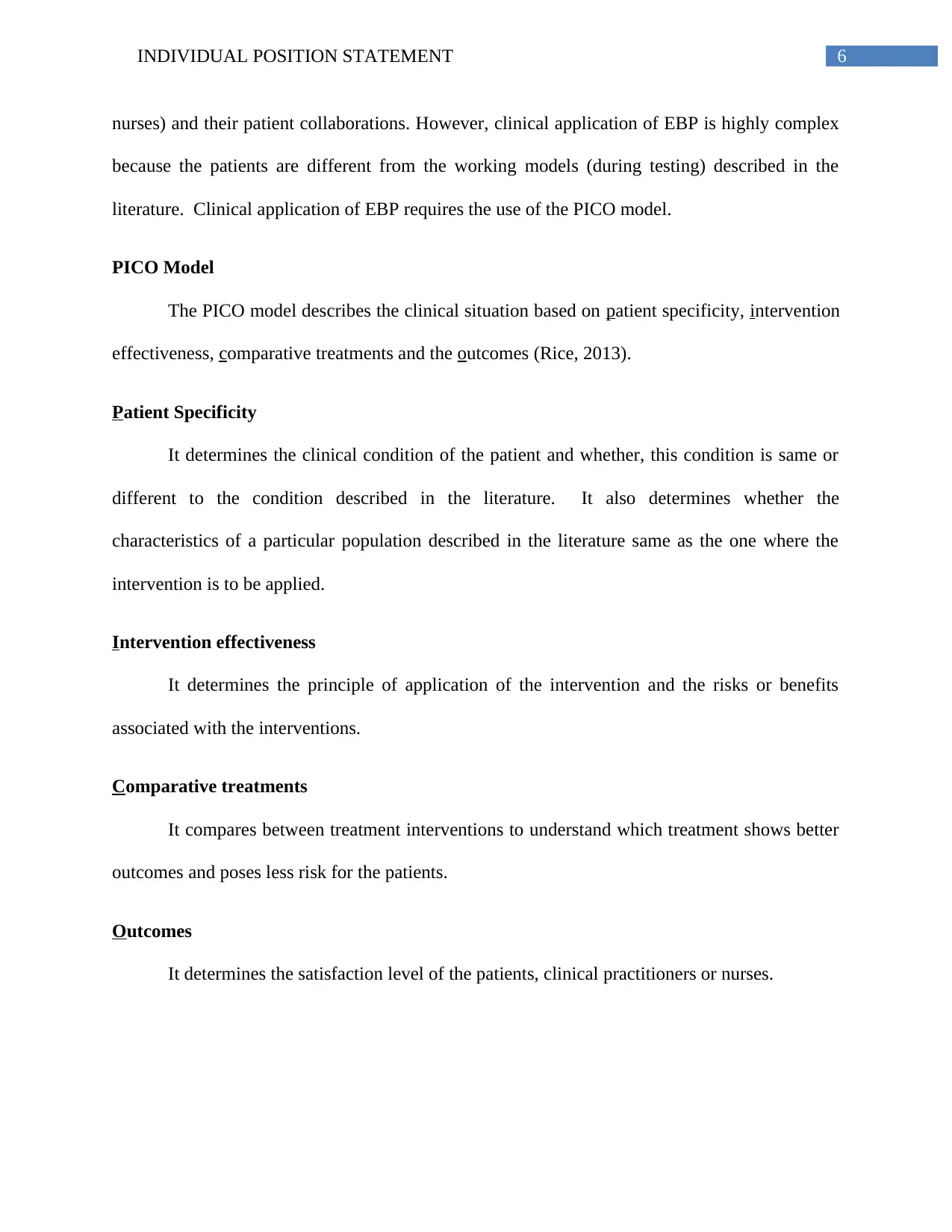
6INDIVIDUAL POSITION STATEMENT
nurses) and their patient collaborations. However, clinical application of EBP is highly complex
because the patients are different from the working models (during testing) described in the
literature. Clinical application of EBP requires the use of the PICO model.
PICO Model
The PICO model describes the clinical situation based on patient specificity, intervention
effectiveness, comparative treatments and the outcomes (Rice, 2013).
Patient Specificity
It determines the clinical condition of the patient and whether, this condition is same or
different to the condition described in the literature. It also determines whether the
characteristics of a particular population described in the literature same as the one where the
intervention is to be applied.
Intervention effectiveness
It determines the principle of application of the intervention and the risks or benefits
associated with the interventions.
Comparative treatments
It compares between treatment interventions to understand which treatment shows better
outcomes and poses less risk for the patients.
Outcomes
It determines the satisfaction level of the patients, clinical practitioners or nurses.
nurses) and their patient collaborations. However, clinical application of EBP is highly complex
because the patients are different from the working models (during testing) described in the
literature. Clinical application of EBP requires the use of the PICO model.
PICO Model
The PICO model describes the clinical situation based on patient specificity, intervention
effectiveness, comparative treatments and the outcomes (Rice, 2013).
Patient Specificity
It determines the clinical condition of the patient and whether, this condition is same or
different to the condition described in the literature. It also determines whether the
characteristics of a particular population described in the literature same as the one where the
intervention is to be applied.
Intervention effectiveness
It determines the principle of application of the intervention and the risks or benefits
associated with the interventions.
Comparative treatments
It compares between treatment interventions to understand which treatment shows better
outcomes and poses less risk for the patients.
Outcomes
It determines the satisfaction level of the patients, clinical practitioners or nurses.
Paraphrase This Document
Need a fresh take? Get an instant paraphrase of this document with our AI Paraphraser
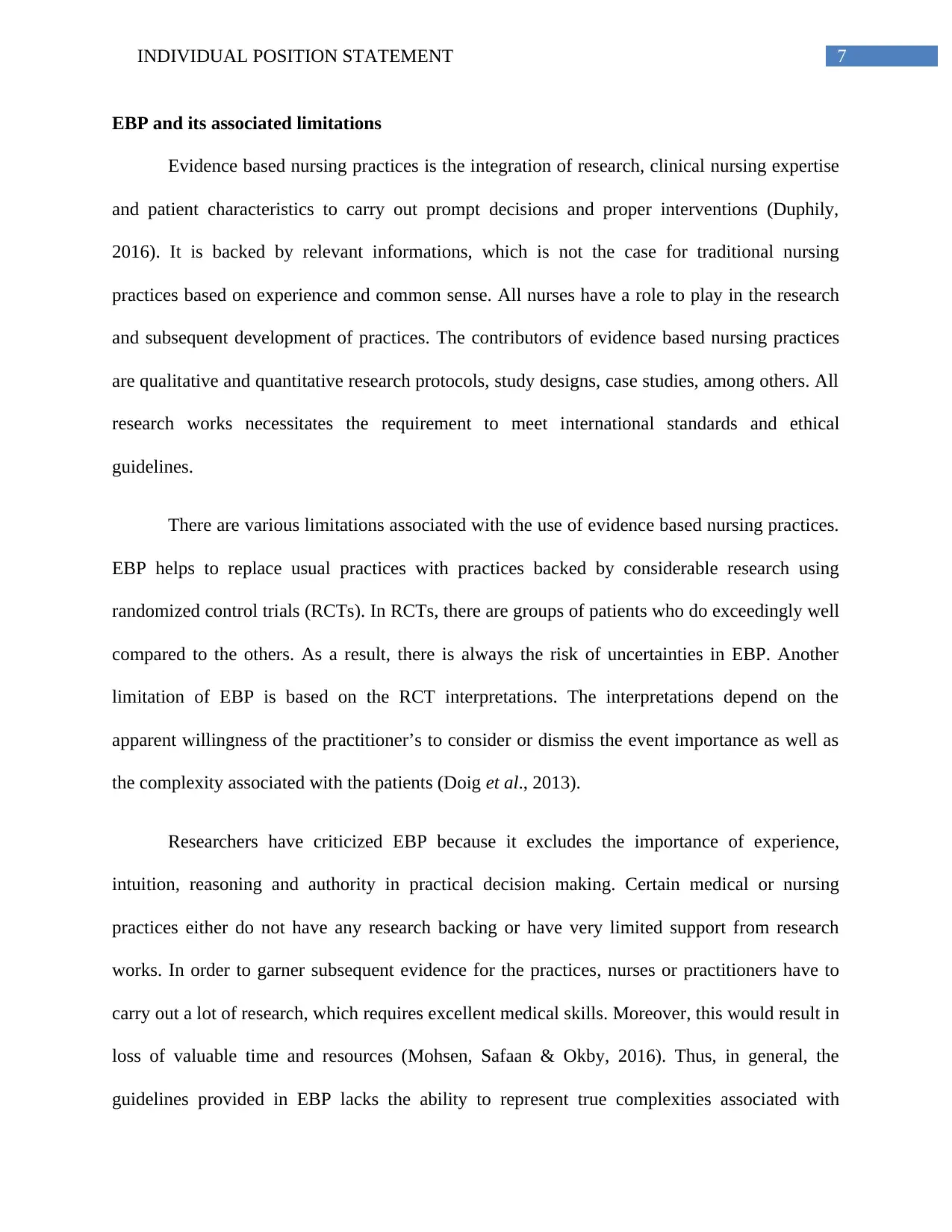
7INDIVIDUAL POSITION STATEMENT
EBP and its associated limitations
Evidence based nursing practices is the integration of research, clinical nursing expertise
and patient characteristics to carry out prompt decisions and proper interventions (Duphily,
2016). It is backed by relevant informations, which is not the case for traditional nursing
practices based on experience and common sense. All nurses have a role to play in the research
and subsequent development of practices. The contributors of evidence based nursing practices
are qualitative and quantitative research protocols, study designs, case studies, among others. All
research works necessitates the requirement to meet international standards and ethical
guidelines.
There are various limitations associated with the use of evidence based nursing practices.
EBP helps to replace usual practices with practices backed by considerable research using
randomized control trials (RCTs). In RCTs, there are groups of patients who do exceedingly well
compared to the others. As a result, there is always the risk of uncertainties in EBP. Another
limitation of EBP is based on the RCT interpretations. The interpretations depend on the
apparent willingness of the practitioner’s to consider or dismiss the event importance as well as
the complexity associated with the patients (Doig et al., 2013).
Researchers have criticized EBP because it excludes the importance of experience,
intuition, reasoning and authority in practical decision making. Certain medical or nursing
practices either do not have any research backing or have very limited support from research
works. In order to garner subsequent evidence for the practices, nurses or practitioners have to
carry out a lot of research, which requires excellent medical skills. Moreover, this would result in
loss of valuable time and resources (Mohsen, Safaan & Okby, 2016). Thus, in general, the
guidelines provided in EBP lacks the ability to represent true complexities associated with
EBP and its associated limitations
Evidence based nursing practices is the integration of research, clinical nursing expertise
and patient characteristics to carry out prompt decisions and proper interventions (Duphily,
2016). It is backed by relevant informations, which is not the case for traditional nursing
practices based on experience and common sense. All nurses have a role to play in the research
and subsequent development of practices. The contributors of evidence based nursing practices
are qualitative and quantitative research protocols, study designs, case studies, among others. All
research works necessitates the requirement to meet international standards and ethical
guidelines.
There are various limitations associated with the use of evidence based nursing practices.
EBP helps to replace usual practices with practices backed by considerable research using
randomized control trials (RCTs). In RCTs, there are groups of patients who do exceedingly well
compared to the others. As a result, there is always the risk of uncertainties in EBP. Another
limitation of EBP is based on the RCT interpretations. The interpretations depend on the
apparent willingness of the practitioner’s to consider or dismiss the event importance as well as
the complexity associated with the patients (Doig et al., 2013).
Researchers have criticized EBP because it excludes the importance of experience,
intuition, reasoning and authority in practical decision making. Certain medical or nursing
practices either do not have any research backing or have very limited support from research
works. In order to garner subsequent evidence for the practices, nurses or practitioners have to
carry out a lot of research, which requires excellent medical skills. Moreover, this would result in
loss of valuable time and resources (Mohsen, Safaan & Okby, 2016). Thus, in general, the
guidelines provided in EBP lacks the ability to represent true complexities associated with
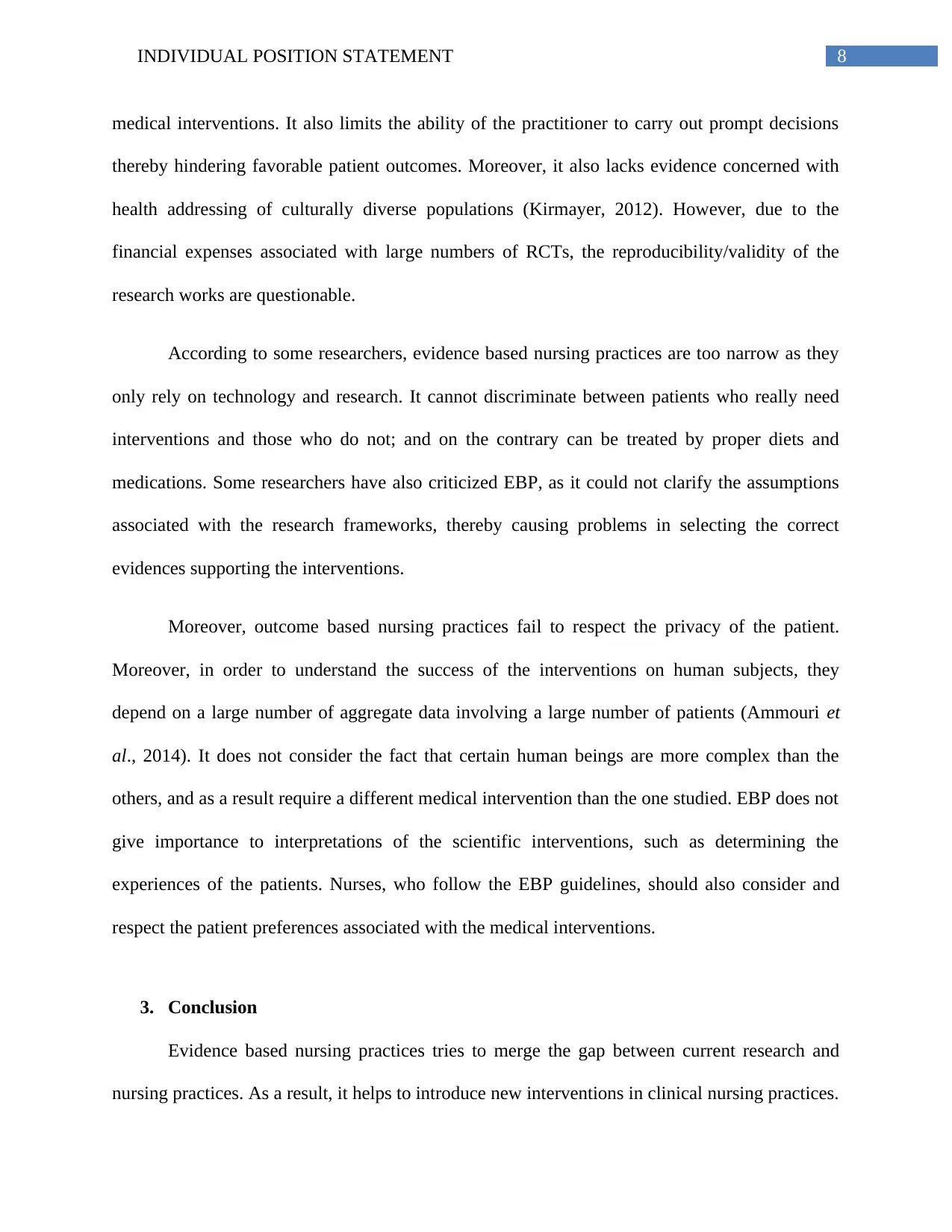
8INDIVIDUAL POSITION STATEMENT
medical interventions. It also limits the ability of the practitioner to carry out prompt decisions
thereby hindering favorable patient outcomes. Moreover, it also lacks evidence concerned with
health addressing of culturally diverse populations (Kirmayer, 2012). However, due to the
financial expenses associated with large numbers of RCTs, the reproducibility/validity of the
research works are questionable.
According to some researchers, evidence based nursing practices are too narrow as they
only rely on technology and research. It cannot discriminate between patients who really need
interventions and those who do not; and on the contrary can be treated by proper diets and
medications. Some researchers have also criticized EBP, as it could not clarify the assumptions
associated with the research frameworks, thereby causing problems in selecting the correct
evidences supporting the interventions.
Moreover, outcome based nursing practices fail to respect the privacy of the patient.
Moreover, in order to understand the success of the interventions on human subjects, they
depend on a large number of aggregate data involving a large number of patients (Ammouri et
al., 2014). It does not consider the fact that certain human beings are more complex than the
others, and as a result require a different medical intervention than the one studied. EBP does not
give importance to interpretations of the scientific interventions, such as determining the
experiences of the patients. Nurses, who follow the EBP guidelines, should also consider and
respect the patient preferences associated with the medical interventions.
3. Conclusion
Evidence based nursing practices tries to merge the gap between current research and
nursing practices. As a result, it helps to introduce new interventions in clinical nursing practices.
medical interventions. It also limits the ability of the practitioner to carry out prompt decisions
thereby hindering favorable patient outcomes. Moreover, it also lacks evidence concerned with
health addressing of culturally diverse populations (Kirmayer, 2012). However, due to the
financial expenses associated with large numbers of RCTs, the reproducibility/validity of the
research works are questionable.
According to some researchers, evidence based nursing practices are too narrow as they
only rely on technology and research. It cannot discriminate between patients who really need
interventions and those who do not; and on the contrary can be treated by proper diets and
medications. Some researchers have also criticized EBP, as it could not clarify the assumptions
associated with the research frameworks, thereby causing problems in selecting the correct
evidences supporting the interventions.
Moreover, outcome based nursing practices fail to respect the privacy of the patient.
Moreover, in order to understand the success of the interventions on human subjects, they
depend on a large number of aggregate data involving a large number of patients (Ammouri et
al., 2014). It does not consider the fact that certain human beings are more complex than the
others, and as a result require a different medical intervention than the one studied. EBP does not
give importance to interpretations of the scientific interventions, such as determining the
experiences of the patients. Nurses, who follow the EBP guidelines, should also consider and
respect the patient preferences associated with the medical interventions.
3. Conclusion
Evidence based nursing practices tries to merge the gap between current research and
nursing practices. As a result, it helps to introduce new interventions in clinical nursing practices.
⊘ This is a preview!⊘
Do you want full access?
Subscribe today to unlock all pages.

Trusted by 1+ million students worldwide
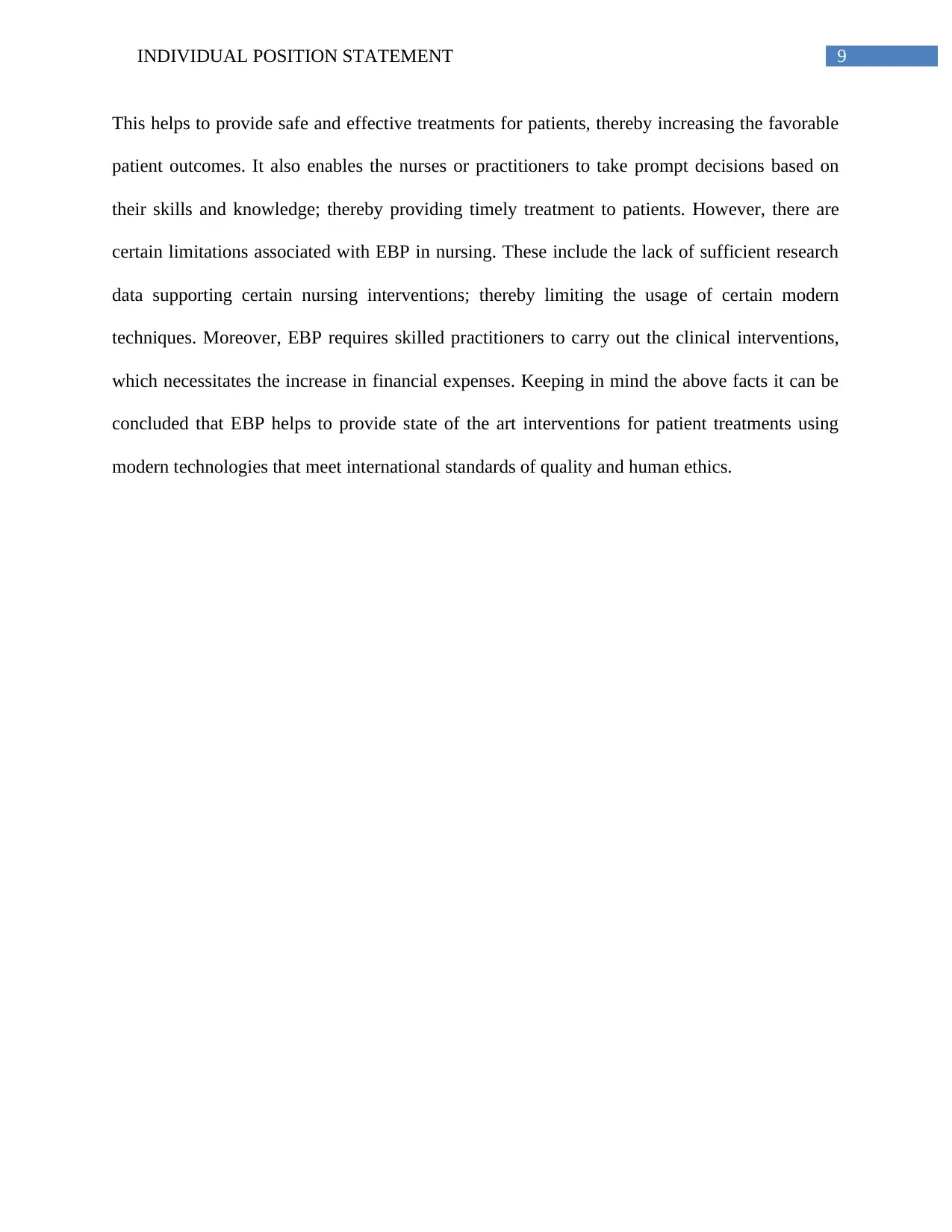
9INDIVIDUAL POSITION STATEMENT
This helps to provide safe and effective treatments for patients, thereby increasing the favorable
patient outcomes. It also enables the nurses or practitioners to take prompt decisions based on
their skills and knowledge; thereby providing timely treatment to patients. However, there are
certain limitations associated with EBP in nursing. These include the lack of sufficient research
data supporting certain nursing interventions; thereby limiting the usage of certain modern
techniques. Moreover, EBP requires skilled practitioners to carry out the clinical interventions,
which necessitates the increase in financial expenses. Keeping in mind the above facts it can be
concluded that EBP helps to provide state of the art interventions for patient treatments using
modern technologies that meet international standards of quality and human ethics.
This helps to provide safe and effective treatments for patients, thereby increasing the favorable
patient outcomes. It also enables the nurses or practitioners to take prompt decisions based on
their skills and knowledge; thereby providing timely treatment to patients. However, there are
certain limitations associated with EBP in nursing. These include the lack of sufficient research
data supporting certain nursing interventions; thereby limiting the usage of certain modern
techniques. Moreover, EBP requires skilled practitioners to carry out the clinical interventions,
which necessitates the increase in financial expenses. Keeping in mind the above facts it can be
concluded that EBP helps to provide state of the art interventions for patient treatments using
modern technologies that meet international standards of quality and human ethics.
Paraphrase This Document
Need a fresh take? Get an instant paraphrase of this document with our AI Paraphraser
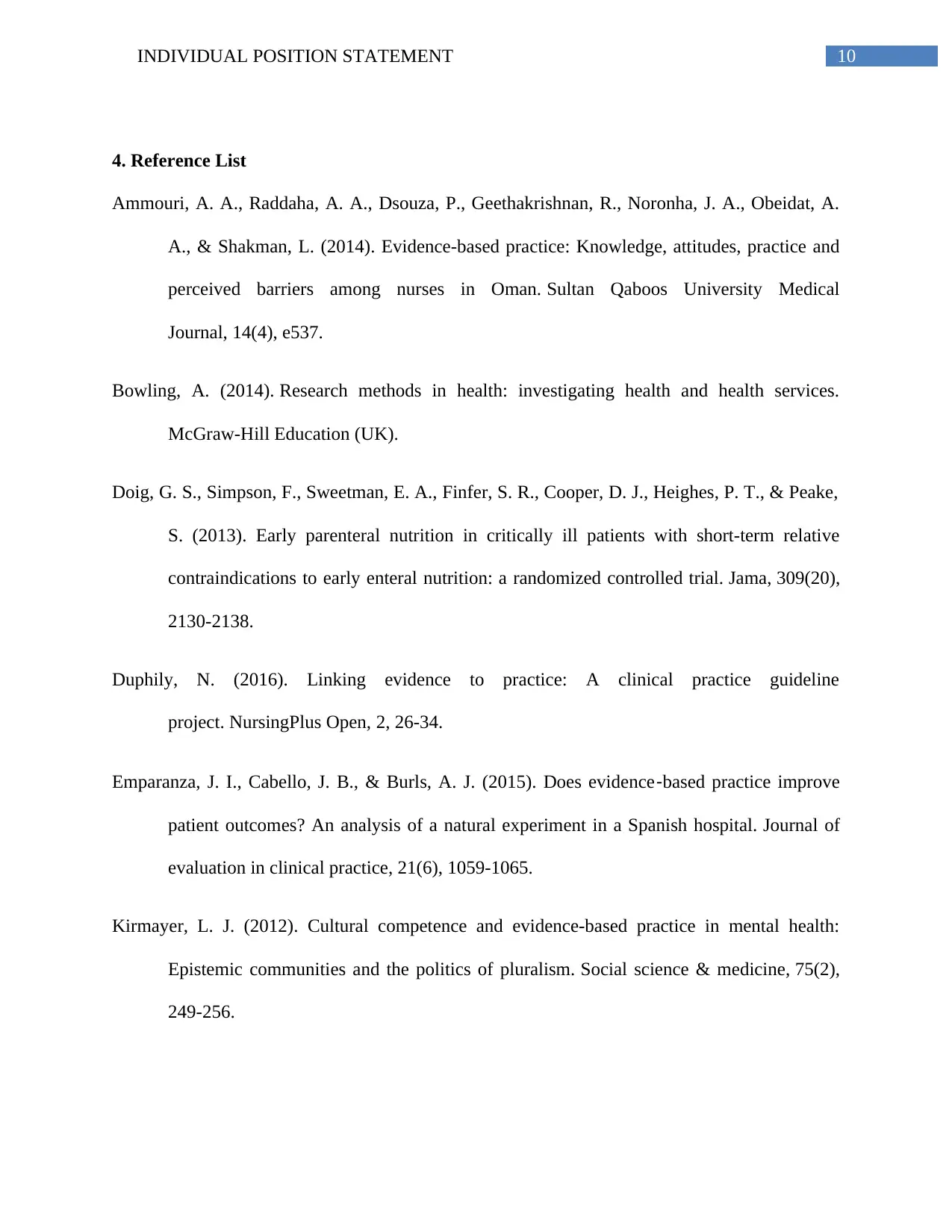
10INDIVIDUAL POSITION STATEMENT
4. Reference List
Ammouri, A. A., Raddaha, A. A., Dsouza, P., Geethakrishnan, R., Noronha, J. A., Obeidat, A.
A., & Shakman, L. (2014). Evidence-based practice: Knowledge, attitudes, practice and
perceived barriers among nurses in Oman. Sultan Qaboos University Medical
Journal, 14(4), e537.
Bowling, A. (2014). Research methods in health: investigating health and health services.
McGraw-Hill Education (UK).
Doig, G. S., Simpson, F., Sweetman, E. A., Finfer, S. R., Cooper, D. J., Heighes, P. T., & Peake,
S. (2013). Early parenteral nutrition in critically ill patients with short-term relative
contraindications to early enteral nutrition: a randomized controlled trial. Jama, 309(20),
2130-2138.
Duphily, N. (2016). Linking evidence to practice: A clinical practice guideline
project. NursingPlus Open, 2, 26-34.
Emparanza, J. I., Cabello, J. B., & Burls, A. J. (2015). Does evidence‐based practice improve
patient outcomes? An analysis of a natural experiment in a Spanish hospital. Journal of
evaluation in clinical practice, 21(6), 1059-1065.
Kirmayer, L. J. (2012). Cultural competence and evidence-based practice in mental health:
Epistemic communities and the politics of pluralism. Social science & medicine, 75(2),
249-256.
4. Reference List
Ammouri, A. A., Raddaha, A. A., Dsouza, P., Geethakrishnan, R., Noronha, J. A., Obeidat, A.
A., & Shakman, L. (2014). Evidence-based practice: Knowledge, attitudes, practice and
perceived barriers among nurses in Oman. Sultan Qaboos University Medical
Journal, 14(4), e537.
Bowling, A. (2014). Research methods in health: investigating health and health services.
McGraw-Hill Education (UK).
Doig, G. S., Simpson, F., Sweetman, E. A., Finfer, S. R., Cooper, D. J., Heighes, P. T., & Peake,
S. (2013). Early parenteral nutrition in critically ill patients with short-term relative
contraindications to early enteral nutrition: a randomized controlled trial. Jama, 309(20),
2130-2138.
Duphily, N. (2016). Linking evidence to practice: A clinical practice guideline
project. NursingPlus Open, 2, 26-34.
Emparanza, J. I., Cabello, J. B., & Burls, A. J. (2015). Does evidence‐based practice improve
patient outcomes? An analysis of a natural experiment in a Spanish hospital. Journal of
evaluation in clinical practice, 21(6), 1059-1065.
Kirmayer, L. J. (2012). Cultural competence and evidence-based practice in mental health:
Epistemic communities and the politics of pluralism. Social science & medicine, 75(2),
249-256.
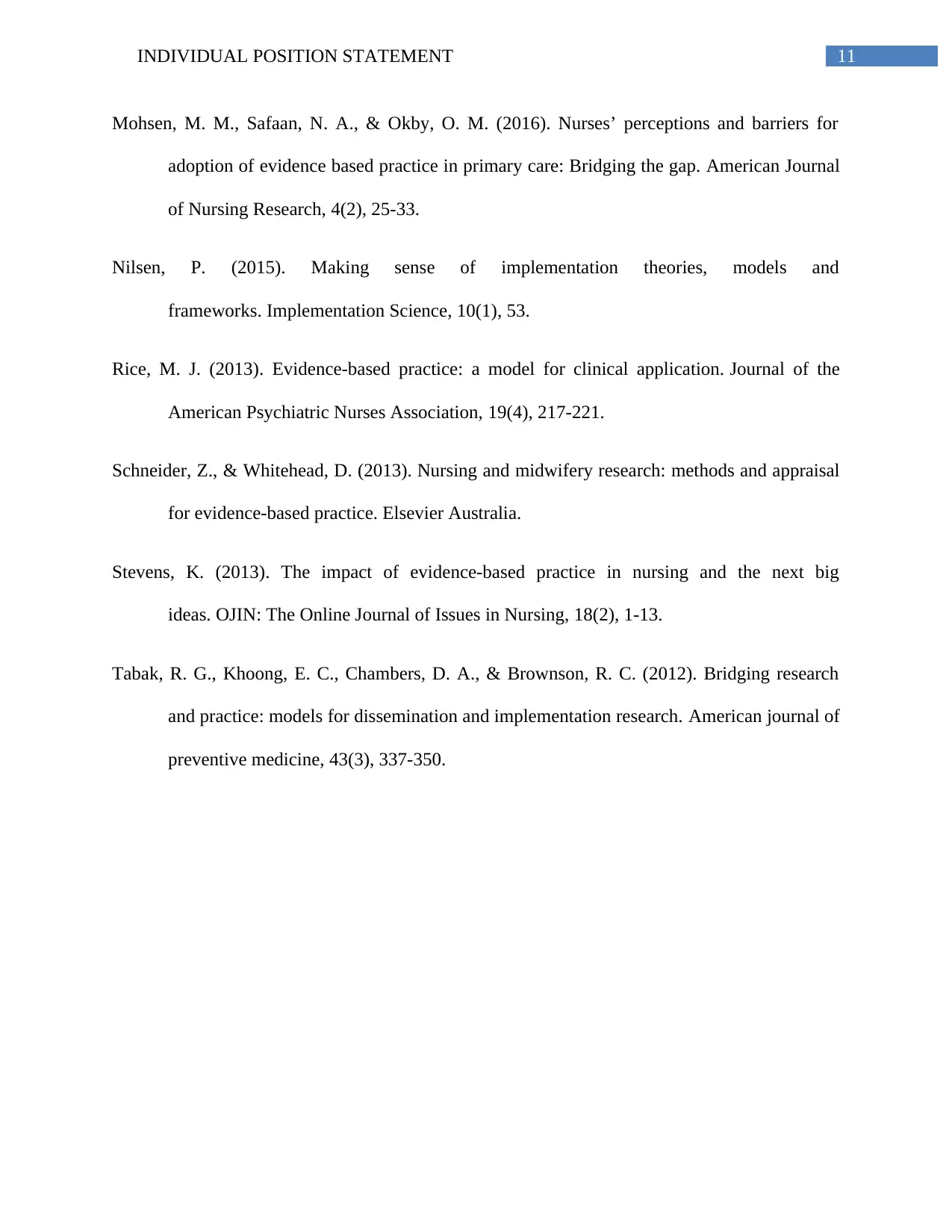
11INDIVIDUAL POSITION STATEMENT
Mohsen, M. M., Safaan, N. A., & Okby, O. M. (2016). Nurses’ perceptions and barriers for
adoption of evidence based practice in primary care: Bridging the gap. American Journal
of Nursing Research, 4(2), 25-33.
Nilsen, P. (2015). Making sense of implementation theories, models and
frameworks. Implementation Science, 10(1), 53.
Rice, M. J. (2013). Evidence-based practice: a model for clinical application. Journal of the
American Psychiatric Nurses Association, 19(4), 217-221.
Schneider, Z., & Whitehead, D. (2013). Nursing and midwifery research: methods and appraisal
for evidence-based practice. Elsevier Australia.
Stevens, K. (2013). The impact of evidence-based practice in nursing and the next big
ideas. OJIN: The Online Journal of Issues in Nursing, 18(2), 1-13.
Tabak, R. G., Khoong, E. C., Chambers, D. A., & Brownson, R. C. (2012). Bridging research
and practice: models for dissemination and implementation research. American journal of
preventive medicine, 43(3), 337-350.
Mohsen, M. M., Safaan, N. A., & Okby, O. M. (2016). Nurses’ perceptions and barriers for
adoption of evidence based practice in primary care: Bridging the gap. American Journal
of Nursing Research, 4(2), 25-33.
Nilsen, P. (2015). Making sense of implementation theories, models and
frameworks. Implementation Science, 10(1), 53.
Rice, M. J. (2013). Evidence-based practice: a model for clinical application. Journal of the
American Psychiatric Nurses Association, 19(4), 217-221.
Schneider, Z., & Whitehead, D. (2013). Nursing and midwifery research: methods and appraisal
for evidence-based practice. Elsevier Australia.
Stevens, K. (2013). The impact of evidence-based practice in nursing and the next big
ideas. OJIN: The Online Journal of Issues in Nursing, 18(2), 1-13.
Tabak, R. G., Khoong, E. C., Chambers, D. A., & Brownson, R. C. (2012). Bridging research
and practice: models for dissemination and implementation research. American journal of
preventive medicine, 43(3), 337-350.
⊘ This is a preview!⊘
Do you want full access?
Subscribe today to unlock all pages.

Trusted by 1+ million students worldwide
1 out of 12
Related Documents
Your All-in-One AI-Powered Toolkit for Academic Success.
+13062052269
info@desklib.com
Available 24*7 on WhatsApp / Email
![[object Object]](/_next/static/media/star-bottom.7253800d.svg)
Unlock your academic potential
Copyright © 2020–2025 A2Z Services. All Rights Reserved. Developed and managed by ZUCOL.





